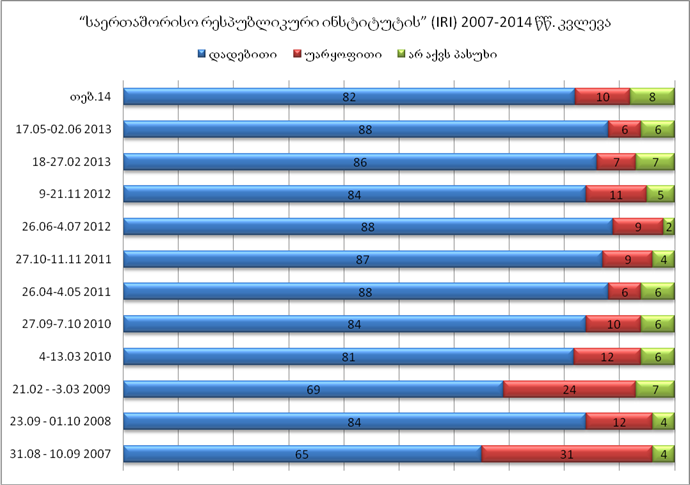A record price for both Saperavi and Rkatsiteli has been registered.” Mr Gharibashvili also noted that the Kakheti region received more than GEL 100 million in profits last year with a grape harvest amounting to 100,000 tons being expected this year.
FactChecktook interest in the current prices for grapes and decided to verify the Prime Minister’s statement.
According to the data of the National Wine Agency, the amount of harvested grapes equalled 116 thousand tons as of 5 October whilst the revenue received from the harvest amounted to GEL 155 million. This means that the price for 1 kilogram of grapes including the subsidy equals GEL 1.34. The highest price (GEL 2.5) recorded was for the Saperavi grape variety. This year, the average price for Saperavi grapes amounted to GEL 1.95 whilst the average price for Rkatsiteli grapes is GEL 1. The Prime Minister’s statement, therefore, according to which the minimum price for grapes is GEL 1 this year,is true.
As for the role of the Government in determining the price for grapes, the state has been subsidising grapes since 2008. The decision on subsidising grapes was adopted by the Government in order to neutralise the negative results of the Russian embargo and stimulate grape growing. The subsidy allocated for 1 kilogram of grapes has been changing in accordance with the ongoing processes in the field. The table shows us the subsidy allocated to increase the grape harvest in 2011-2013.
Table 1: Subsidy Allocated to Increase the Grape Harvest in 2011-2013
| Grape Variety | 2011 | 2012 | 2013 | |
| Rkatsiteli | Subsidy (GEL million) | 3.1 | 9.4 | 24.8 |
| Number of grapes processed (thousand tons) | 20.9 | 37.6 | 62 | |
| Saperavi | Subsidy (GEL million) | 5.6 | 5.2 | 6.4 |
| Number of grapes processed (thousand tons) | 22.3 | 15 | 25.8 |
In 2013, the subsidy for 1 kilogram of Saperavi grapes was GEL 0.25 whilst the subsidy allocated for 1 kilogram of Rkatsiteli grapes equalled GEL 0.40. In 2014, there were talks on suspending the subsidising of Saperavi grapes in order to boost the demand for this particular grape variety; finally, however, the subsidy was reduced to GEL 0.15 for Saperavi grapes and GEL 0.35 for Rkatsiteli grapes. FactCheck has already written
on this topic.
We should also note the fact that this year the Government is only subsidising grapes that are being purchased by factories for no less than GEL 1 which means that the Government is contributing to sustaining the minimum price of grapes fixed at GEL 1.At the end of 2012, Russia removed the embargo on Georgian production which had a positive effect upon Georgia’s wine export and has led to an increase in the demand for grapes. Particularly, the quantity of exported wine increased 1.8 times in 2013 whilst profits earned from wine export have doubled as compared to 2012, amounting to USD 130 million. The aforementioned situation has a positive effect on the price for grapes and their production. Taking into account the positive changes in the field, therefore, we can assume that grape growing and wine making are in a position for independent development and that the time has come for the state to allow the market to determine the price for grapes and gradually begin a stoppage of the practice of subsidisation.
According to the data provided by the Ministry of Agriculture, the weighted average price for 1 kilogram of Saperavi grapes (without the subsidy) was GEL 0.98 in 2013 whilst the price for 1 kilogram of Rkatsiteli grapes equalled GEL 0.73. In addition, the grape harvest was subsidised in 2013; more precisely, the subsidy for 1 kilogram of Saperavi grapes was GEL 0.25 whilst the subsidy for 1 kilogram of Rkatsiteli grapes was GEL 0.40.Therefore, the average wholesale price in 2013 was higher than the price of GEL 1 with the current year being the first year in which high prices for grapes have been recorded.
Graph 1: Weighted Average Price for Grapes (Saperavi and Rkatsiteli) in 2008-2013
 Source: Ministry of Agriculture
Source: Ministry of Agriculture
As for grape production, it amounted to 129.5 thousand tons in 2013 according to the information of the National Statistics Office of Georgia whilst grape production throughout the country equalled 228.8 thousand tons. In the Kakheti region, the amount of grapes processed to produce wine amounted to 92 thousand tons generating a revenue of GEL 108 million. This year, the number of processed grapes increased to 116 thousand tons with revenues amounting to GEL 155 million.
Conclusion High prices for grapes have been recorded in this year’s harvest. High prices were also seen in the harvest of 2013. Subsidisation of the grape harvest took place this year. The subsidy for 1 kilogram of Saperavi grapes is GEL 0.15 and GEL 0.35 for 1 kilogram of Rkatsiteli grapes. It should be noted that the Government only gives out the subsidy if the wholesale price for the grapes is not lower than GEL 1.
Therefore, the Government contributes to determining the minimum price for grapes. As for the harvest, according to the National Wine Agency, the quantity of grapes processed is equal to 116 thousand tons with revenues amounting to GEL 155 million.
FactCheck concludes that Irakli Gharibashvili’s statement, “With the Government’s support, the minimum price for one kilogram of grapes is one lari. A record price for both Saperavi and Rkatsiteli grapes has been registered,” is TRUE.





 “With the Government’s support, the minimum price for one kilogram of grapes is one lari. A record price for both Saperavi and Rkatsiteli grapes has been registered.”
“With the Government’s support, the minimum price for one kilogram of grapes is one lari. A record price for both Saperavi and Rkatsiteli grapes has been registered.”











